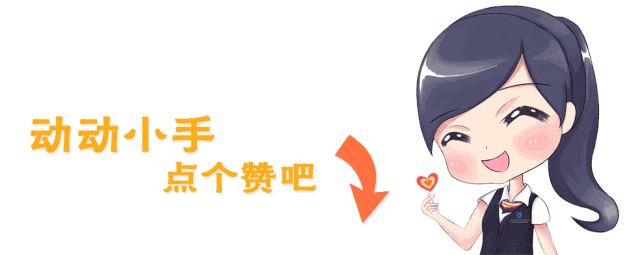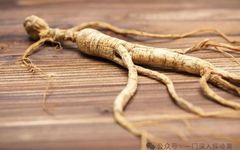

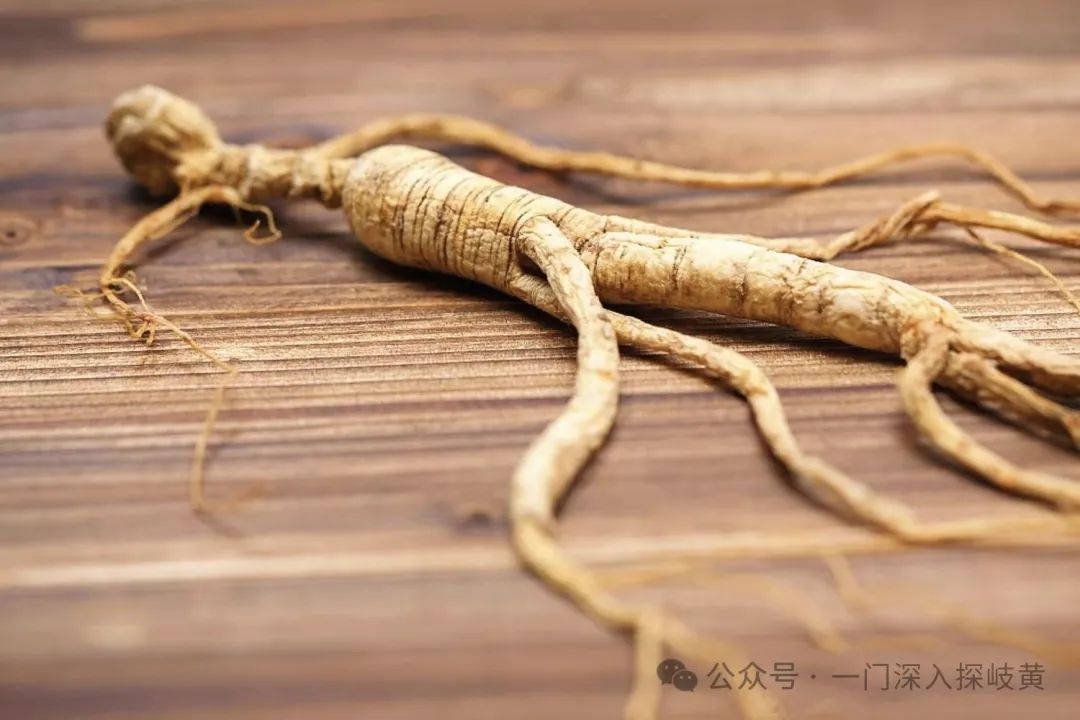 When it comes to Ginseng (Ren Shen), everyone is likely familiar with it. Its efficacy is unparalleled, as it greatly replenishes Yuan Qi (元气) and is the primary medicine for treating Xu Lao (虚劳)! The medical book from the Yuan Dynasty, Shiyao Shenfang (十药神方), records the formula Dushen Decoction (独参汤), which uses 2 taels of ginseng and 5 large dates boiled in water for frequent consumption. This can greatly replenish Yuan Qi and rescue from critical conditions, often used to treat severe symptoms such as pale complexion, cold limbs, excessive sweating, weak breathing, and faint pulse due to severe deficiency of Yuan Qi and sudden loss of Yang Qi (阳气). Today, at the request of my fans, I will briefly discuss this medicinal herb, ginseng!
When it comes to Ginseng (Ren Shen), everyone is likely familiar with it. Its efficacy is unparalleled, as it greatly replenishes Yuan Qi (元气) and is the primary medicine for treating Xu Lao (虚劳)! The medical book from the Yuan Dynasty, Shiyao Shenfang (十药神方), records the formula Dushen Decoction (独参汤), which uses 2 taels of ginseng and 5 large dates boiled in water for frequent consumption. This can greatly replenish Yuan Qi and rescue from critical conditions, often used to treat severe symptoms such as pale complexion, cold limbs, excessive sweating, weak breathing, and faint pulse due to severe deficiency of Yuan Qi and sudden loss of Yang Qi (阳气). Today, at the request of my fans, I will briefly discuss this medicinal herb, ginseng!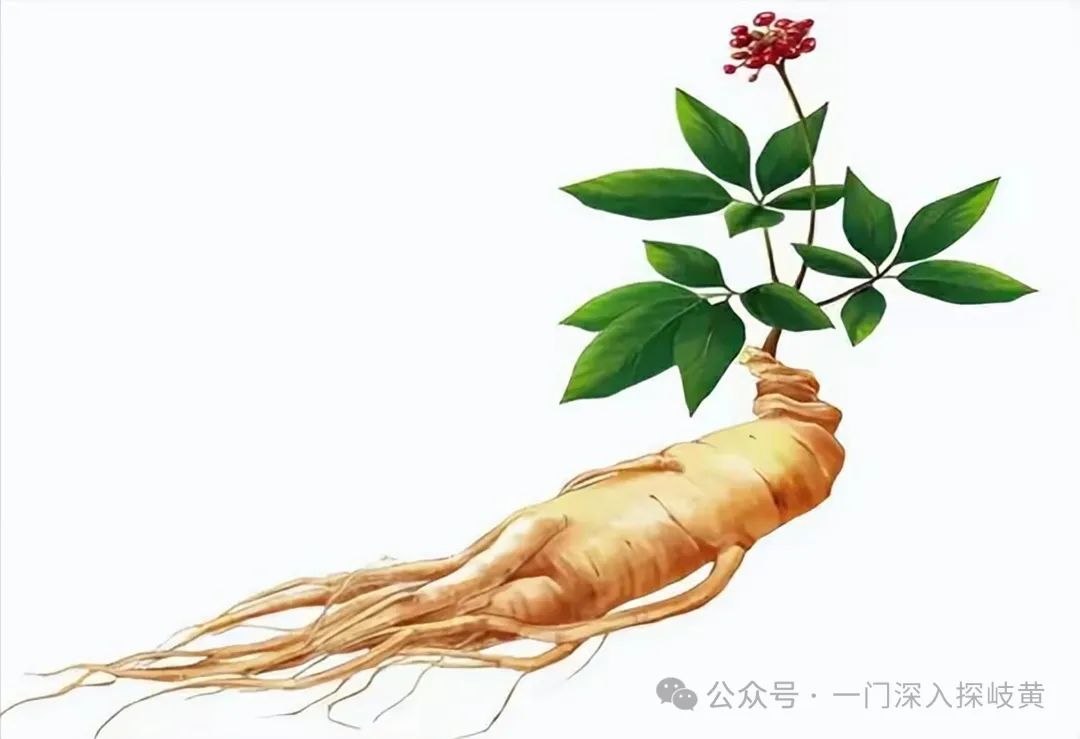 Ginseng (Ren Shen) belongs to the Araliaceae family and is a semi-shade perennial herbaceous plant. It is a relic plant from the Tertiary period, with a history of about 60 million years. Ginseng is mainly distributed in eastern Liaoning, eastern Jilin, and eastern Heilongjiang, with small amounts introduced in Hebei, Shanxi, and Shandong. Among these, Fusong County in Jilin, located in the central part of Changbai Mountain, has superior natural conditions such as water, land, and forest resources, making it the original production area of Changbai Mountain ginseng and the main production area of authentic Chinese ginseng. There is a saying: “The world’s ginseng is in China, Chinese ginseng is in Jilin, and Jilin ginseng is from Fusong.” As a traditional medicinal material in China, ginseng not only has a long cultivation history but also has been used medicinally for thousands of years. It was first recorded in the Shennong Bencao Jing (神农本草经) and is known as the “King of Herbs (百草之王)”, a precious medicinal material renowned both domestically and internationally. According to the Shennong Bencao Jing, ginseng has the effects of “tonifying the five organs, stabilizing the soul, stopping palpitations, eliminating evil qi, brightening the eyes, and enhancing intelligence.” Long-term use can lighten the body and prolong life. The Pharmacopoeia of the People’s Republic of China summarizes the effects of ginseng as: greatly tonifying Yuan Qi, restoring pulse and stabilizing collapse, tonifying the spleen and benefiting the lungs, generating fluids and nourishing blood, calming the spirit and enhancing intelligence. It is used for symptoms such as dry body with a tendency to collapse, cold limbs with faint pulse, spleen deficiency with little appetite, lung deficiency with cough, fluid damage with thirst, internal heat with thirst, deficiency of qi and blood, prolonged illness with weakness, palpitations and insomnia, impotence, and cold uterus. Modern medical research shows that ginseng can resist aging, improve memory, prevent dementia, enhance heart function, boost immunity, combat fatigue, relieve stress, improve sexual function, regulate the nervous system, and beautify the skin. My experience: ginseng mainly tonifies the qi of the organs, so taking ginseng to tonify qi will not let the qi escape but rather draw it inward, as it can also enter the kidneys (which govern storage). This is also called “tonifying Yuan Qi”, which is the reason behind it. Medical texts state that “ginseng benefits the five organs”, so those with deficiency or chronic illness often feel sleepy or easily fall into a good sleep after taking ginseng, which is actually a specific manifestation of its tonifying heart qi!
Ginseng (Ren Shen) belongs to the Araliaceae family and is a semi-shade perennial herbaceous plant. It is a relic plant from the Tertiary period, with a history of about 60 million years. Ginseng is mainly distributed in eastern Liaoning, eastern Jilin, and eastern Heilongjiang, with small amounts introduced in Hebei, Shanxi, and Shandong. Among these, Fusong County in Jilin, located in the central part of Changbai Mountain, has superior natural conditions such as water, land, and forest resources, making it the original production area of Changbai Mountain ginseng and the main production area of authentic Chinese ginseng. There is a saying: “The world’s ginseng is in China, Chinese ginseng is in Jilin, and Jilin ginseng is from Fusong.” As a traditional medicinal material in China, ginseng not only has a long cultivation history but also has been used medicinally for thousands of years. It was first recorded in the Shennong Bencao Jing (神农本草经) and is known as the “King of Herbs (百草之王)”, a precious medicinal material renowned both domestically and internationally. According to the Shennong Bencao Jing, ginseng has the effects of “tonifying the five organs, stabilizing the soul, stopping palpitations, eliminating evil qi, brightening the eyes, and enhancing intelligence.” Long-term use can lighten the body and prolong life. The Pharmacopoeia of the People’s Republic of China summarizes the effects of ginseng as: greatly tonifying Yuan Qi, restoring pulse and stabilizing collapse, tonifying the spleen and benefiting the lungs, generating fluids and nourishing blood, calming the spirit and enhancing intelligence. It is used for symptoms such as dry body with a tendency to collapse, cold limbs with faint pulse, spleen deficiency with little appetite, lung deficiency with cough, fluid damage with thirst, internal heat with thirst, deficiency of qi and blood, prolonged illness with weakness, palpitations and insomnia, impotence, and cold uterus. Modern medical research shows that ginseng can resist aging, improve memory, prevent dementia, enhance heart function, boost immunity, combat fatigue, relieve stress, improve sexual function, regulate the nervous system, and beautify the skin. My experience: ginseng mainly tonifies the qi of the organs, so taking ginseng to tonify qi will not let the qi escape but rather draw it inward, as it can also enter the kidneys (which govern storage). This is also called “tonifying Yuan Qi”, which is the reason behind it. Medical texts state that “ginseng benefits the five organs”, so those with deficiency or chronic illness often feel sleepy or easily fall into a good sleep after taking ginseng, which is actually a specific manifestation of its tonifying heart qi!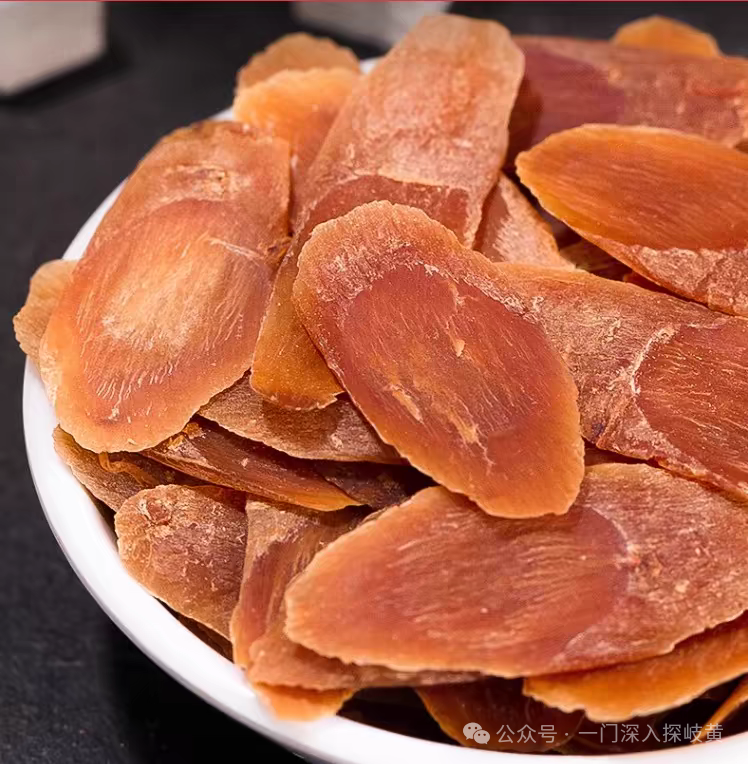 Traditional Chinese medicine emphasizes processing, and ginseng is no exception! In terms of processing methods, ginseng can be divided into fresh ginseng, red ginseng, sun-dried ginseng, and sugar ginseng. Among these, fresh ginseng and sun-dried ginseng are excellent for clear tonification, focusing on benefiting qi and generating fluids, calming the spirit; while red ginseng and sugar ginseng are excellent for warm tonification, focusing on greatly tonifying Yuan Qi and restoring pulse, but sugar ginseng has less medicinal value than red ginseng. I will detail the most commonly used red ginseng and sun-dried ginseng! Sun-dried ginseng and red ginseng are processed products, both of which can be used for medicine and daily nourishment. Red ginseng is ginseng that has been processed to a reddish color; its essence is still ginseng. The ginseng sold in pharmacies is referred to as “sun-dried ginseng (Sheng Shai Shen)” or “white ginseng (Bai Shen)”. As the name suggests, it is freshly dug ginseng that is cleaned and directly sun-dried, hence called “sun-dried ginseng”. If you do not directly sun-dry the ginseng after harvesting but instead clean it and steam it in a pot, then dry it, and repeat this process several times, the color will turn reddish, and it is named “red ginseng”. The name red ginseng is to distinguish it from “sun-dried ginseng”; its essence is still ginseng. Why steam it? The simplest understanding is to remove moisture and coldness, making the ginseng warmer in nature, which is more suitable for those with deficiency and coldness. Additionally, the medicinal properties of the two types of ginseng differ! Sun-dried ginseng is neutral in nature, sweet, and slightly bitter, entering the lungs, spleen, and heart meridians, with effects of greatly tonifying Yuan Qi, tonifying the spleen and benefiting the lungs, generating fluids, and calming the spirit. Red ginseng has a warm nature, with stronger qi tonifying properties, greatly tonifying Yang Qi, restoring pulse, and benefiting qi and blood, suitable for those with chronic illness and deficiency, and those who are afraid of cold, such as the “Poge Jiu Xin Tang (破格救心汤)” created by the famous TCM doctor Li Ke, which contains red ginseng. The renowned Sheng Mai Yin (生脉饮) (red ginseng formula) also primarily uses red ginseng!
Traditional Chinese medicine emphasizes processing, and ginseng is no exception! In terms of processing methods, ginseng can be divided into fresh ginseng, red ginseng, sun-dried ginseng, and sugar ginseng. Among these, fresh ginseng and sun-dried ginseng are excellent for clear tonification, focusing on benefiting qi and generating fluids, calming the spirit; while red ginseng and sugar ginseng are excellent for warm tonification, focusing on greatly tonifying Yuan Qi and restoring pulse, but sugar ginseng has less medicinal value than red ginseng. I will detail the most commonly used red ginseng and sun-dried ginseng! Sun-dried ginseng and red ginseng are processed products, both of which can be used for medicine and daily nourishment. Red ginseng is ginseng that has been processed to a reddish color; its essence is still ginseng. The ginseng sold in pharmacies is referred to as “sun-dried ginseng (Sheng Shai Shen)” or “white ginseng (Bai Shen)”. As the name suggests, it is freshly dug ginseng that is cleaned and directly sun-dried, hence called “sun-dried ginseng”. If you do not directly sun-dry the ginseng after harvesting but instead clean it and steam it in a pot, then dry it, and repeat this process several times, the color will turn reddish, and it is named “red ginseng”. The name red ginseng is to distinguish it from “sun-dried ginseng”; its essence is still ginseng. Why steam it? The simplest understanding is to remove moisture and coldness, making the ginseng warmer in nature, which is more suitable for those with deficiency and coldness. Additionally, the medicinal properties of the two types of ginseng differ! Sun-dried ginseng is neutral in nature, sweet, and slightly bitter, entering the lungs, spleen, and heart meridians, with effects of greatly tonifying Yuan Qi, tonifying the spleen and benefiting the lungs, generating fluids, and calming the spirit. Red ginseng has a warm nature, with stronger qi tonifying properties, greatly tonifying Yang Qi, restoring pulse, and benefiting qi and blood, suitable for those with chronic illness and deficiency, and those who are afraid of cold, such as the “Poge Jiu Xin Tang (破格救心汤)” created by the famous TCM doctor Li Ke, which contains red ginseng. The renowned Sheng Mai Yin (生脉饮) (red ginseng formula) also primarily uses red ginseng!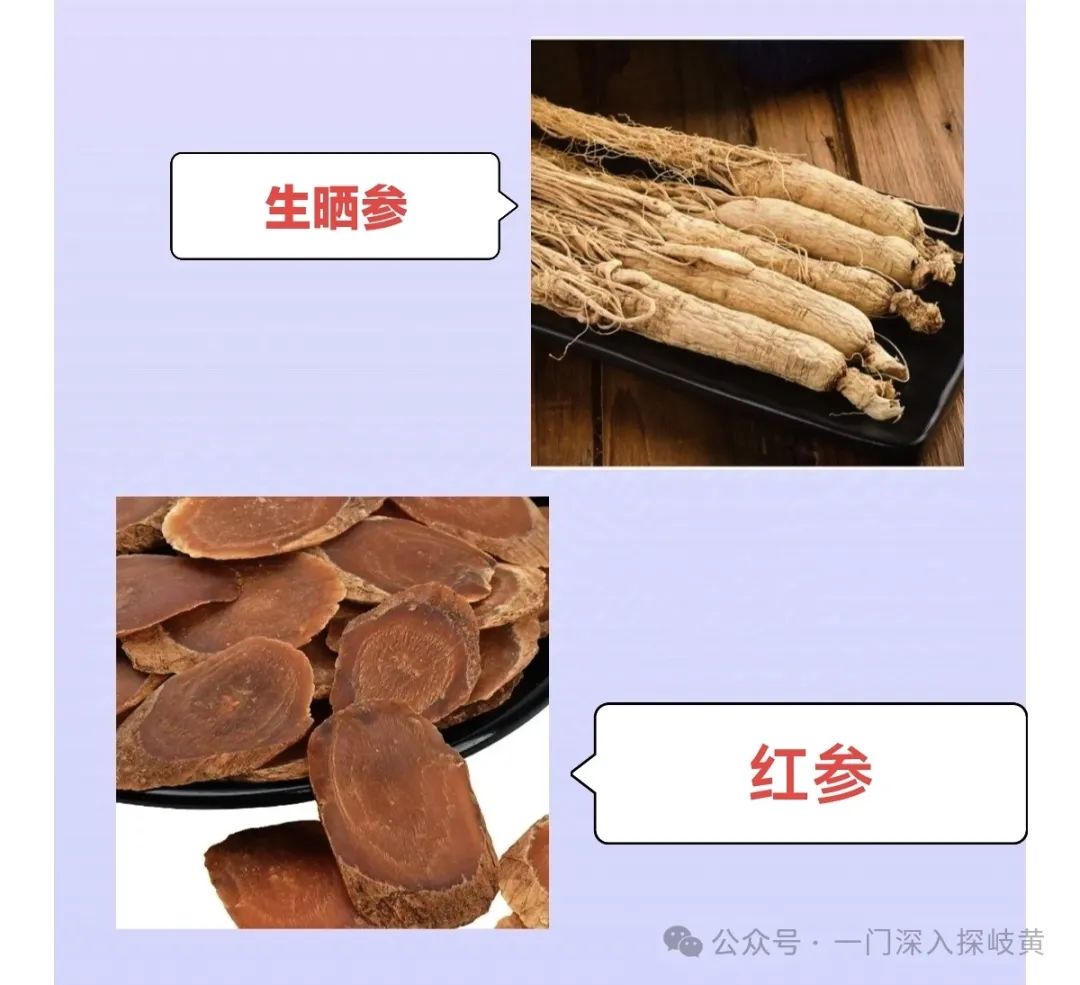 Let me also talk about the grades and sources of ginseng! Ginseng can be roughly divided into three grades, which are greatly related to their growing environment. The first type is “wild mountain ginseng (天然野山参)”, which has a very long growth period of at least 20-30 years, and is rare and hard to find. After decades of exposure to wind and rain, and years of accumulation, it not only has the best medicinal properties but also the highest quality, though the yield is very low and the price is very high, generally regarded as a high-end gift, and is rarely seen in the market. The second type is “forest ginseng (林下参)”, which can be divided into two methods: sowing ginseng seeds and transplanting ginseng seedlings, both of which mimic the growing environment of wild mountain ginseng. The seed-sown method involves directly sowing ginseng seeds in the forest and allowing them to grow naturally without human intervention, resulting in low germination and survival rates, but the quality of the finished product is closest to wild mountain ginseng. The seedling transplant method involves first cultivating seedlings in a seedbed for one or two years, then transplanting them to the forest, which has a higher survival rate but lower quality from a commercial perspective. Comparatively, both types of forest ginseng have good quality, but the yield is low and the price is not cheap. Generally, the whole root ginseng packaged in exquisite boxes is likely to be “forest ginseng.” The third type is the most common “garden ginseng (园参)”, which is cultivated in high-density seedbeds and then dispersed to ginseng fields, with full manual management, and a growth cycle of about five years. The quality is average, the price is lower, and the yield is very high; most of the ginseng slices found in pharmacies are processed from garden ginseng! At the end of the article, “Doctor Sun” reminds everyone: Ginseng is a great tonic, rare and precious, and its price is relatively high. If used merely for daily health maintenance, it seems a bit of an overuse. However, if given to someone recovering from a serious illness, it can be a timely help. But when purchasing precious medicinal materials, one must identify them clearly and always buy from reputable Chinese medicine institutions to avoid spending a high price for inferior products.
Let me also talk about the grades and sources of ginseng! Ginseng can be roughly divided into three grades, which are greatly related to their growing environment. The first type is “wild mountain ginseng (天然野山参)”, which has a very long growth period of at least 20-30 years, and is rare and hard to find. After decades of exposure to wind and rain, and years of accumulation, it not only has the best medicinal properties but also the highest quality, though the yield is very low and the price is very high, generally regarded as a high-end gift, and is rarely seen in the market. The second type is “forest ginseng (林下参)”, which can be divided into two methods: sowing ginseng seeds and transplanting ginseng seedlings, both of which mimic the growing environment of wild mountain ginseng. The seed-sown method involves directly sowing ginseng seeds in the forest and allowing them to grow naturally without human intervention, resulting in low germination and survival rates, but the quality of the finished product is closest to wild mountain ginseng. The seedling transplant method involves first cultivating seedlings in a seedbed for one or two years, then transplanting them to the forest, which has a higher survival rate but lower quality from a commercial perspective. Comparatively, both types of forest ginseng have good quality, but the yield is low and the price is not cheap. Generally, the whole root ginseng packaged in exquisite boxes is likely to be “forest ginseng.” The third type is the most common “garden ginseng (园参)”, which is cultivated in high-density seedbeds and then dispersed to ginseng fields, with full manual management, and a growth cycle of about five years. The quality is average, the price is lower, and the yield is very high; most of the ginseng slices found in pharmacies are processed from garden ginseng! At the end of the article, “Doctor Sun” reminds everyone: Ginseng is a great tonic, rare and precious, and its price is relatively high. If used merely for daily health maintenance, it seems a bit of an overuse. However, if given to someone recovering from a serious illness, it can be a timely help. But when purchasing precious medicinal materials, one must identify them clearly and always buy from reputable Chinese medicine institutions to avoid spending a high price for inferior products.

